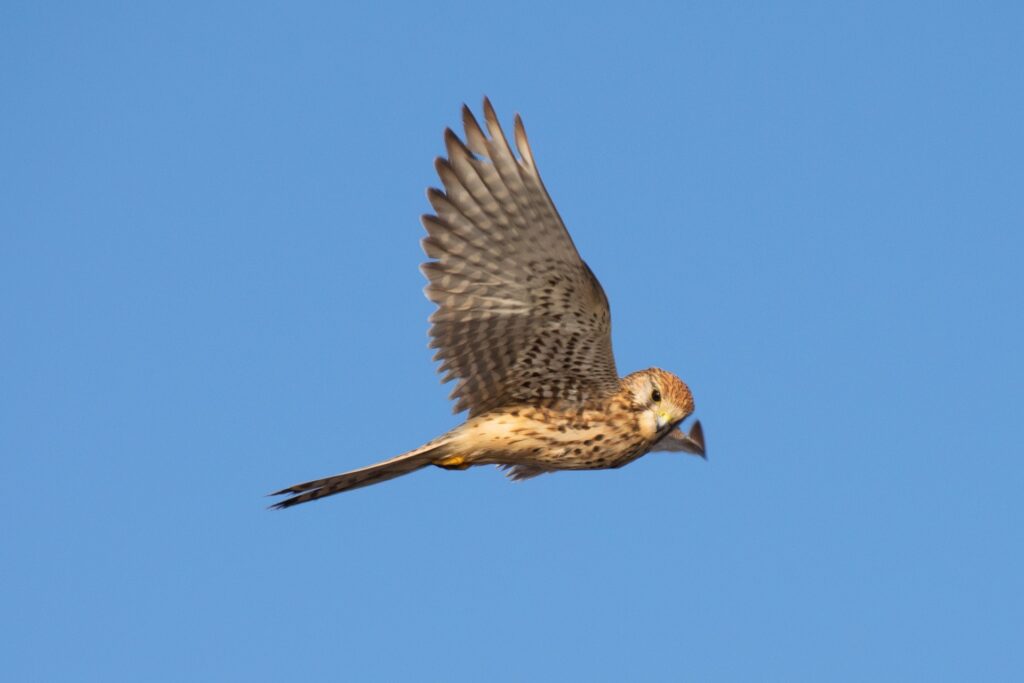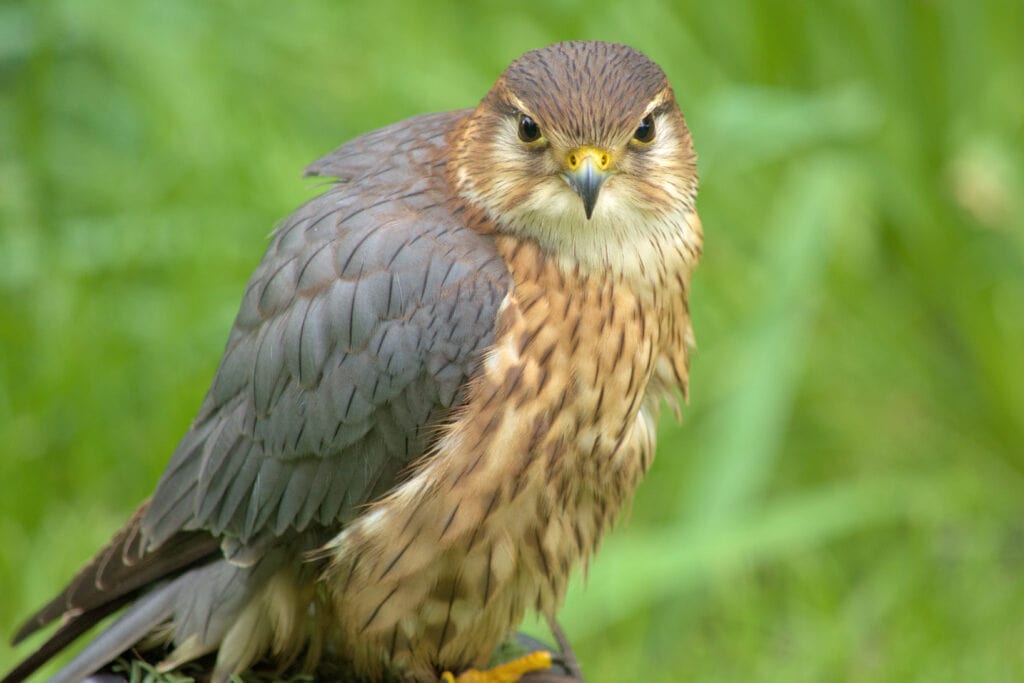The Merlin is a small species of falcon which is well-known for its speed and maneuverability. Merlins are exceptional hunters, but the most incredible superlative attached to these birds is the fact that they are the namesake of one of the most interesting and useful pieces of birdwatching technology around. Merlin is the name of the Cornell Lab of Ornithology’s bird identification software. Using millions of birdwatchers’ reports to eBird, the Merlin app asks the user a series of questions in order to narrow down the possible birds that fit the description of their sighting. The app is a fantastic tool for experienced birders and beginners alike. Merlin is even capable of generating lists of possible IDs for birds based upon sound recordings and photographs. Since its 2014 launch, Merlin has cemented itself as one of the new essential tools in a birdwatcher’s toolbelt. (1)
The Merlin may not be the most ubiquitous bird, but it isn’t too hard to imagine why it was chosen as a namesake for this revolutionary software. For one thing, Merlins represent a major conservation success story as their populations have recovered from a dangerously steep decline. We’ll discuss that in detail in the next section. Another thing that makes the Merlin a great spokes-bird for the Merlin app is the fact that these falcons are incredibly quick and can be very difficult to spot and identify. The Merlin app is designed to make identification easier, so even quick sightings can be identified!

Beyond their connection with the Cornell Lab of Ornithology and its bird identification software, Merlins have a long history with human cultures. They are traditional falconry birds and were historically used by noblewomen. In this article, we’ll take a deep look at Merlins and their unique gifts as well as their relationships with various human cultures.
Merlin Symbolism and Meaning
Thanks to the Merlin app, Merlins now have a pretty firm association with the birdwatching hobby and the thrill of identifying birds. On top of this, they are very often connected with conservation and preservation. Merlins suffered from sharp population declines in the twentieth century thanks to the use of the pesticide, DDT. DDT saw widespread use beginning around the 1950s and the negative impact of this chemical upon bird populations was noticed fairly quickly. DDT affects the ways that birds process calcium. Calcium is a necessary component of eggshells and with DDT in their environments, many birds became unable to produce eggshells strong enough to incubate their young. (2)
This phenomenon brought many populations into decline including, famously, Bald Eagles. Once conservation efforts began, it took decades for populations to bounce back. The Merlin is one of the DDT stories that has a truly uplifting ending. Despite being seriously impacted by DDT, Merlins are currently listed as having a conservation status of “Least Concern” within the United States. (3)

Merlins may represent chaos or panic. This is because of their propensity for hunting large flocks of birds, such as waxwings or pigeons. In fact, in some parts of North America, Merlins are known colloquially as “pigeon hawks.” The reason this connects them with panic is that these large flocks of birds break out into sudden bursts of panicked activity when a Merlin attacks. Merlins will even hunt in pairs sometimes, with one bird attacking the flock from below and flushing it upwards while the other bird intercepts the panicked flock, taking advantage of their confusion. (4)
In the previous section, we mentioned how Merlins have a long history with falconry. The length and character of this history is demonstrated by this passage from a medieval manuscript:
“An Eagle for an Emperor, a Gyrfalcon for a King; a Peregrine for a Prince, a Saker for a Knight, a Merlin for a Lady; a Goshawk for a Yeoman, a Sparrowhawk for a Priest, a Musket for a Holy water Clerk, a Kestrel for a Knave.”
— The Book of Saint Albans c. 1486 (5)
Merlins are described as a lady’s falcon and this holds true for much of their history with falconry. Both Catherine the Great and Mary Queen of Scots are recorded to have used Merlins to hunt small birds for sport. Merlins were supposedly used for the hunting of skylarks in particular. (6)

So, Merlins may represent nobility, femininity, or the sport of falconry.
Another fun fact about Merlins is that they do not construct their own nests. This means that Merlins must get by by taking over the nests of other birds. From corvids to other raptors, Merlins steal unclaimed nests and use them for their own young. For this reason, Merlins may represent theft or intrusion as well as instability.
Merlin Native American Symbolism
While Merlins are not named specifically in any of the Native American sources that I was able to track down, falcons on the whole do feature in quite a few legends and are the subject of a range of symbolic meanings. Falcons are often portrayed as symbols of protection, courage, and acuity. In legends, they are inhabitants of the realm of heaven.
Merlin Christianity Symbolism
Merlins are not found in the Bible, nor are falcons in general mentioned. However, birds of prey are typically used to represent unmanaged wilderness and desolation as in the following passage:
“ It shall never be inhabited, neither shall it be dwelt in from generation to generation: neither shall the Arabian pitch tent there; neither shall the shepherds make their fold there. But wild beasts of the desert shall lie there; and their houses shall be full of doleful creatures; and owls shall dwell there, and satyrs shall dance there.”
— Isaiah 13:20-22 (7)
Merlin Celtic Symbolism
The association between Merlins and Celtic mythology seems quite obvious. The wizard, Merlin, of Arthurian legend originates from Welsh mythology. Merlin is often portrayed as a talented wizard with incredible supernatural abilities. he is a sage and a prophet, however he is also prone to madness and is capable of wreaking incredible mayhem. Merlin is a key figure in the story of King Arthur and is responsible for many of Arthur’s successes. The only problem with this is the fact that the Merlin of Welsh myth and Arthurian legend and the avian Merlin are not at all related. The Welsh Merlin comes from the old Brythonic name, “Myrddin.” Whereas the name “Merlin” in the case of the birds is derived from the old French word “esmerillon,” which was the old French name for this species. Thus, Merlin the wizard and Merlin the bird are connected only by name. Still, one might choose to connect Merlins with magic, wisdom, foresight, or the supernatural. (8)(9)
Merlin in Dreams
Dreaming of a Merlin may indicate focus. These birds are known for their abilities as hunters. They are fast, efficient, and capable of snatching small prey right out of the air. To dream of a Merlin may indicate a goal with which the dreamer is preoccupied.
A Merlin dream may also indicate that the dreamer is worried about an intruder in their home or routine. Merlins often takeover the nests of other birds since they cannot build their own. Dreaming of a Merlin may indicate that the dreamer feels insecure. The dreamer may fear that another person is threatening to take their place or oust them from their roles in their loved ones’ lives.
Merlin Encounters and Omens
A Merlin encounter may represent panic or fear. Merlins are known to disturb large flocks of birds by flying swiftly into their midst to capture their prey. Encountering a Merlin may be an indicator that one needs to confront the source of their fear or discomfort rather than fleeing blindly from it.

A Merlin encounter may also represent honor or nobility. Merlins represent regality and respect. Such an encounter can be a reminder to know your worth and own your power with pride.
Merlin in Mythology & Folklore
Merlins don’t feature prominently in many myths. They are, however, similar to other falcons and can be connected with other falcon myths which are prevalent around the globe.
Native American Mythology:
According to one Native American myth, the first falcons were born from a man who fell in love with a maiden from the realm of the stars. Each day, the star maiden and her sisters would descend to earth in a basket and dance. One day, a great hunter named Waupee saw them and fell in love with the youngest sister. The sisters were skittish, though, and would flee to the heavens when Waupee got too close. So one day, he tricked the sisters by hiding in a stump with a bunch of mice. When the sisters chased the mice, he snatched the youngest and she became his bride. Waupee and his bride loved each other dearly and she grew accustomed to life on earth. When she gave birth to a son, though, she longed to show him the land of the stars. So, she brought him up to the sky in her basket. When Waupee saw that they had gone he wept until the chief of the stars took pity on him and brought him up to the heavens too. There, the chief gave Waupee and his wife a mission. They were asked to gather an identifiable piece of every animal on earth. So, Waupee hunted and brought the wings, claws, and feet of all of the animals. Then each of the star people chose one part and they transformed into the animal that they chose. Waupee and his wife and son chose the feathers of the falcon. Thus, the three of them became the source of the falcons of the world. (10)
Egyptian Mythology:
The Egyptian god Horus, is represented by the falcon. Horus is the successor to the king of the gods and is the ruler of the world. According to legend, he is destined to defeat the evil god who slew his father. The eye of Horus is commonly used as a symbol of vision, protection, and foresight. (11)
Merlin Spirit Animal
If your spirit animal is the Merlin then you are likely outgoing, agreeable, and ambitious. People with the Merlin as their spirit animal are very goal-oriented, but they are still great at communicating and cooperating with like-minded peers. This social skill makes the Merlin a great leader who knows how to help their followers’ talents shine.

People with the Merlin as their spirit animal tend to be efficient and are great at achieving the results that they envision.
Merlin Totem Animal
The Merlin totem animal is connected with foresight and prophecy. Like flocks of birds which react to danger before they even consciously perceive it, the Merlin totem helps you to intuit the natural flow of events and react accordingly. People with the Merlin as their totem animal have strong gut instincts and should be cautioned to listen to their gut, even when it seems illogical.
Merlin Power Animal
The power of the Merlin is determination. Although quite a small bird of prey, Merlins are capable of hunting all manner of prey thanks to their speed, acuity, and ability to cooperate. In short, the Merlin is undaunted by its challenges and finds ways to succeed even when success seems unlikely. This single-minded determination is a powerful strength which should not be underestimated.
Merlin Tattoo Meaning
A Merlin tattoo may represent the birdwatching hobby, conservation, or the natural world. In addition, one might choose a Merlin tattoo to represent the protection of the “eye of Horus,” or the myth of the wizard, Merlin, although this myth is not truly connected with this bird.
A Merlin tattoo may also represent determination, foresight, or focus.
Conclusion
From sharp decline to thriving populations, the Merlin had already achieved the impossible when it was chosen as the namesake for the Cornell Lab’s bird identification software. Hopefully, after reading this article, you’ll understand why this special little bird of prey deserves every bit of attention that it receives!

